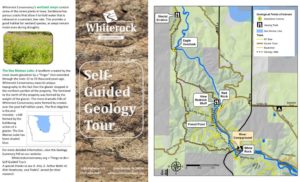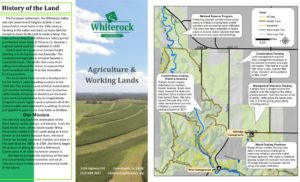Meehan ’17 at Whiterock Conservancy in Coon Rapids, Iowa
Aug 08, 2016I am now about a month into my time in Coon Rapids, Iowa, a time that has been personally challenging in a number of ways. I usually dread co-ops. They tend to be a time of loneliness and economic strain. For some reason, I was actually looking forward to this co-op—probably a combination of frustration with my classes for being too abstract and a romanticization of working at a nature conservancy. I thought that I would finally be doing tangible work for a cause that I believed in and I would be able to spend all of my downtime exploring trails in the beautiful Iowa summer. In some respects I was right—my employer really is an agent for positive change. The area of my ignorance, though, resided in my romanticization of working in nature.
I should probably start with some background information on my employer. Whiterock Conservancy is a non-profit nature conservancy located in Coon Rapids, Iowa. The non-profit is sustained in large part by the Garst family. The family started accumulating their fortune in the middle of the 20th century when Roswell Garst became one of the first individuals to sell hybridized seed corn—an invention that allowed for mechanized harvesting of corn since it causes all of the corn stalks to grow to the same height. The family began gaining clout in progressive politics almost immediately (so much so that they formed a friendship with Nikita Khrushchev). Many of the Garsts have used their name and economic advantage to work in industries such as banking, thus ensuring that they can continue donating money and land to Whiterock Conservancy.
Whiterock itself functions as a nature conservancy, an ecotourism location, and a model for sustainable agriculture. The property boasts miles of trails used for mountain bike, equestrian, and pedestrian use. The conservancy is sure to utilize the least intrusive methods possible for building and maintaining these trails. Whiterock makes further use of ecotourism by hosting weddings, family reunions, and campers on its picturesque grounds. The staff at Whiterock pair with local experts and professors to study the ecosystem, remove invasive species, and reintroduce indigenous ones. It is not rare to see signs warning visitors to be careful around certain areas since there are reintroduced bald eagles or ospreys nesting. The conservancy is dedicated to the notion that human use and local ecosystems can coexist, and its sustainable agriculture program serves to demonstrate this. Cattle, bison, and goats roam the land, but the staff moves the animals around the property to avoid depleting the nutrients in the fields. Progressive farming experiments such as prairie strips are tested out on Whiterock’s crops to allow state universities to find the most sustainable ways to feed America moving forward.
Usually, their interns come from a background in environmental science and tend to do research and practice sustainable agriculture at the conservancy. We have varied my job description from that approach since my skills reside more in media and communication. That being said, I still do work for the land manager half of the time. I do things like monitoring plant growth and some basic manual labor. However, I also spend half of my time working for the director of communication. I have done a lot of photography for her, including aerial photography with a drone, as well as worked on creating brochures for guests and donors and updating the website.
The dilemma is that the work that I do with the land manager is much more of what I was expecting out of the co-op. I get to be outside, exercise and directly contribute to the health of the ecosystem. However, I am not especially experienced or talented in this field, so I feel like I am offering less to the organization when I try to be an environmental science specialist. My media knowledge, on the other hand, allows me to bring unique and beneficial skills to the conservancy. I can write code for the website and use Photoshop, skills that the other employees do not possess. That also means that I have to sit in front of a computer for hours on end to tweak website settings—not exactly what I had in mind when I was approaching this co-op. I have tried to balance the two aspects of the job to varying success.
Overall, this co-op has challenged a lot of my presuppositions. I thought that this field would be a perfect fit for my future career, but it turns out that I might have been applying a false narrative to environmental science. Even though the focus of the work is still on ecosystems, the work setting differs little from other office jobs. Workers in the field still spend a tremendous amount of time confined to their office, sitting in front of a computer.
Construction, Home Preservation, and Outreach: Nate Meehan ’17 at Habitat for Humanity
Feb 09, 2016Habitat for Humanity is a non-profit organization that works to provide decent, affordable housing to millions of homeowners in need all over the world. The organization is run by Habitat for Humanity International, but consists of local chapters all over the world which work with a large degree of autonomy to provide housing in their communities. The specific chapter that I am working with on my co-op is Habitat for Humanity: Greater Orlando. Our chapter is one of the most successful and active chapters in the country which, during my co-op, just reached the milestone of building its 250th home. The homes are built mainly through the efforts of volunteers who work under the leadership of crew leaders (particularly dedicated volunteers) and construction supervisors (full time employees with career experience in construction).
People who are interested in becoming a homeowner first attend information sessions to see if they might qualify. The qualifications to become a homeowner include a demonstrated need for housing, low income, decent credit, and a lack of a criminal record. Next, those prospective applicants can apply to become a Habitat for Humanity homeowner, but the process is not over if they are accepted. The organization does not believe that simply handing out cheap housing is the best way to insure success. The homeowners are to become involved in the process of building a Habitat home by putting in from 300 to 500 sweat equity hours during which they might assist in the building of another homeowner’s house. Also, they are to complete several courses in fields related to homeownership such as basic home repairs and budgeting. Once the home is built and the homeowner’s commitments are fulfilled, they buy their home for either the appraisal cost or the cost of building (whatever is lower) and pay it off on a zero percent interest loan.
My Place in Habitat
As a construction intern, my daily tasks revolve around exactly what the title entails they might: I usually work directly on the construction of homes. However, this does not limit my learning experience to one in which I just learn trades. My role in Habitat is ever evolving and changing, giving me a variety of experiences to take away from this co-op. Typically, I work with the volunteers in the field, with the home preservation program, or with the outreach department.
Construction
The bulk of our construction is done by volunteers; though, we also hire subcontractors to do the jobs that require a large degree of skill. The volunteers are at the build sites often; we have volunteers approximately three times per week. Depending on the job task, we can have anywhere from 5 to 60 volunteers on any given day. My role with regard to these volunteers is to act as a crew leader. I do not have the authority of the full-time construction supervisors (and, indeed, I should not), but I am placed with several volunteers to insure that they complete their task properly. This position exposes me to a myriad of different people with varying life experiences, prompting me to adapt to each one and grow in my communication skills.
Home Preservation
As part of a grant from Universal Studios, Habitat has been commissioned to do small exterior repairs and full exterior wall painting on 100 homes in the next two years. Due to this opportunity, Habitat has dedicated a large portion of its resources to this program. Thus, I work with this program on most days in which we do not have volunteers. During the preliminary stages, I help assess the state of the house and do the small exterior repairs. This teaches a lot of home repairs skills that are much more practical than the roofing or framing that I might learn in construction. Then, on the last day that we work on a particular home, Universal sends in a group of volunteers to paint the house. During these days, I am usually the second highest ranking employee on the site, so my leadership skills are tested along with my painting knowledge.
Outreach
I have also been called upon to do my part with the communication aspect of Habitat. The organization makes use of my comfort with public speaking by calling upon me several times to speak to prospective donors and at events. Also, my basic understanding of photography has proven to be the most training that anyone in the organization has in the field, so I have served as the resident photographer a few times. Lastly, I have been a part of coordination with several news outlets, as we commonly have newspapers and news stations visiting us at our sites.





